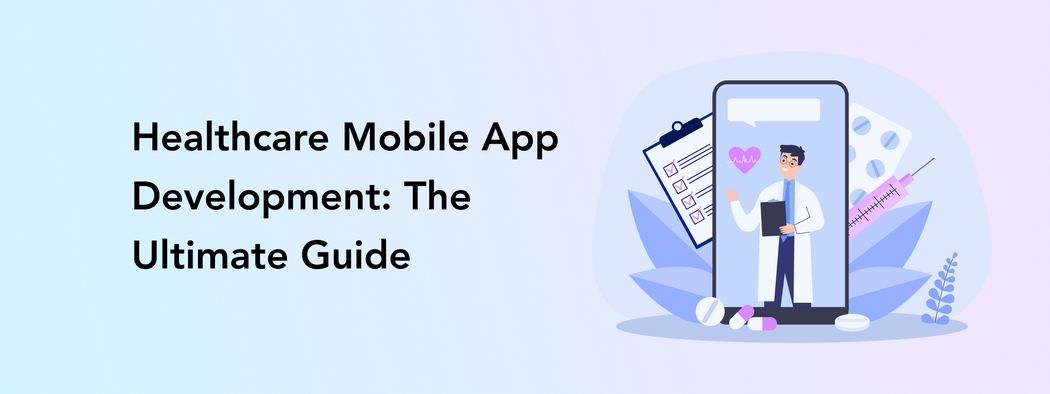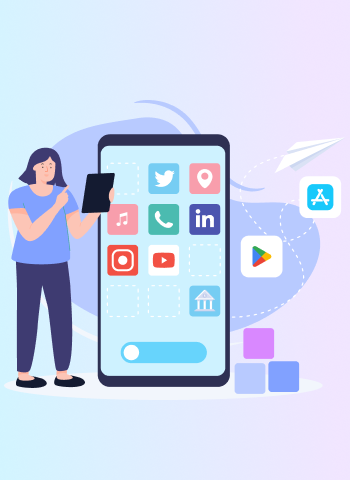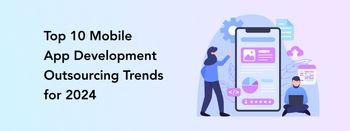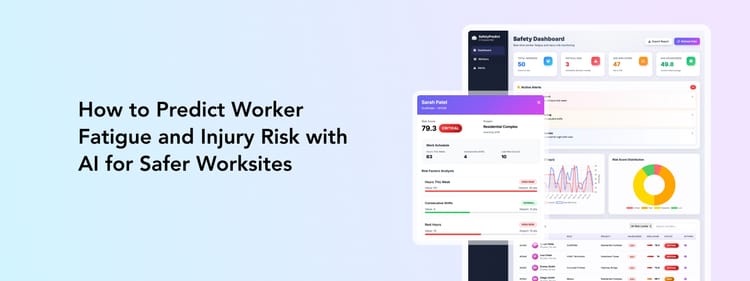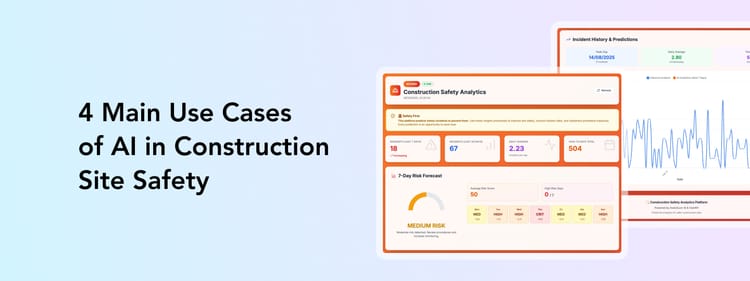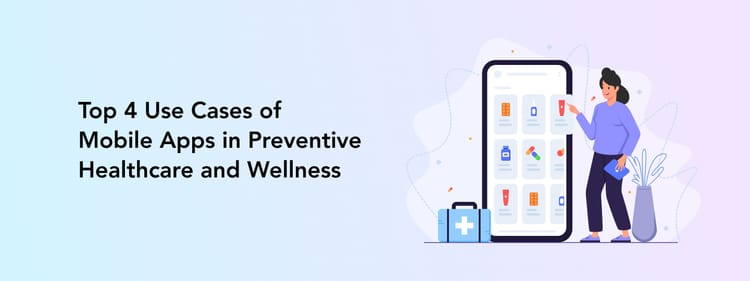Technology has already made most industries more effective and customer-friendly. It continues to transform our everyday experiences for the better. Healthcare is no different.
Consider this: two-thirds of Americans have used a health-related app in the last 12 months. That’s for a good reason: healthcare applications bring countless benefits to medical professionals, clinic administrative staff, and, of course, patients.
The convenience of appointment-making, telemedicine functionality, and access to health records from the app – these are just some reasons why both doctors and patients turn to healthcare apps for their interactions.
Unsurprisingly, many healthcare institutions are now interested in getting a medical app. Let’s learn what are the main types of healthcare apps, what features any medical app needs, how to build such an app, and how much it can all cost.
Main Types of Healthcare Apps
The global mHealth apps market was estimated at USD 43.5 billion in 2022. This number is only expected to grow in the coming years at a compound annual growth rate of 11.6% until 2030. As for the most common app types, 97% of healthcare apps are medical applications, like clinic management products or telehealth solutions.
Let’s explore the main types of healthcare apps dominating the market.
Clinic management apps
A clinic management app is a one-stop shop for all the administrative tasks of a clinic, hospital, or any other medical organization. Instead of calling, filling in tons of paperwork, and checking in in person, both patients and doctors can manage everything appointment-related in one app.
Usually, such apps have a patient side and a doctor or manager side.
The features of a clinic management app can include
- Making and viewing appointments
- Patient check-in
- Managing billing and insurance claims
- Accessing appointment notes, diagnoses, treatment plans, etc through an Electronic Health Record (EHR)
- Checking the specialist’s availability or schedule through a calendar
- Tracking medical inventory
The feature scope can vary depending on the particular clinic’s needs and goals.
Patient portal apps
Some medical institutions choose to go with a separate dedicated patient portal app. This solution is designed solely for patients to access their health information and interact with healthcare professionals.
An Electronic Health Record (EHR) is an integral part of any patient portal app or a medical app all in all. It is a file storing all the medical information about a patient, including previous hospital visits, diagnoses, test results, treatments, and so on.
Plus, a patient can receive lab reports, test results, treatment plans, and even e-prescriptions – all in the app.
A useful feature of a patient portal app is secure messaging with a doctor or nurse for clarifications or quick assistance. You can also add some health resources to educate patients about common conditions or a healthy lifestyle.
Telehealth apps
Telehealth apps are the biggest new thing in the healthcare industry. It is a real revolution in the way patients receive medical assistance – instead of rushing to a clinic for a symptom check-up or refilling a prescription, a person can talk with a doctor via video or audio call or even receive a short consultation in messages.
In most telehealth applications, users can choose a doctor based on their specialization, experience, reviews, and even language preference.
Such apps are a way out for those living in remote areas without easy access to hospitals, travelers who prefer a medical consultation in their native language, or those who cannot visit a clinic due to financial or insurance issues.
Pharmacy apps
Pharmacy applications help managers and pharmacists overlook their supply, have better control over the available stock, and accept e-prescriptions from customers.
One important functionality of a pharmacy app is online ordering and delivery. The app can basically become an online store with prescription-free medications and supplements. Plus, users can check the medicine availability in the app before paying a visit to the pharmacy.
Usually, there is a search bar for medications and detailed information on dosing, usage, and so on for each medicine. As a result, an app becomes somewhat of a pharmaceutical encyclopedia for users when they need to check anything about a product.
Health and habit-tracking apps
Health and habit-tracking apps are personalized digital wellness companions, offering individuals a platform to monitor and enhance their overall well-being. These apps allow tracking healthy habits, such as physical activities or water intake.
Within these apps, users can track a range of health metrics, from weight and blood pressure to sleep patterns and heart rate. Many of these apps seamlessly sync with wearable devices, providing real-time data and a comprehensive view of their health status.
Remote patient monitoring apps
Many hospitals have already enjoyed the benefits of remote patient monitoring solutions. Instead of spending precious doctor’s or nurse’s time for routine blood pressure or blood sugar level tests, medical professionals can assist patients in need of immediate attention while the AI in the app will inform them about any abnormalities with remote patients’ vital signs.
Such apps empower patients, particularly those with chronic conditions, to proactively manage their health from the comfort of their homes. RPM apps offer a range of essential features, including vital signs monitoring, symptom tracking, medication management, and appointment scheduling.
One of the critical advantages of RPM apps is the secure transmission of patient-generated health data to healthcare providers. Real-time monitoring allows healthcare teams to stay informed about their patient's health status. Alerts and notifications are generated for abnormal readings or critical health events, prompting timely interventions when necessary.
Women’s health apps
Another common healthcare app type is women’s health apps. Women’s health apps market size was valued at $3.2 billion in 2022. Yes, the market is quite big, as the largest app – Flo – has more than 36 million monthly users.
Fertility tracking is a common feature, enabling women to monitor menstrual cycles, track ovulation, and identify fertile windows for family planning. Expecting mothers benefit from pregnancy monitoring tools that help track milestones, monitor fetal development, and receive guidance on prenatal care, nutrition, and exercise.
Menstrual cycle tracking features allow users to record and predict cycles, monitor symptoms, and receive notifications about periods or ovulation. Contraceptive management tools help women track birth control methods, set reminders for pill intake, and access information about contraceptive options.
Top Features of a Healthcare Application
The feature set for healthcare apps depends on the app type. While a certain feature might be a must for, let’s say, a clinic management app, it is redundant for a patient monitoring solution.
That’s why it’s best to collaborate with an experienced healthcare app development partner who can advise on the most fitting feature set for a particular app and objectives.
Let’s explore the most common healthcare features to consider adding to your healthcare application.
Electronic health record (EHR) integration
EHR integration allows seamless access to patients' medical records, enabling healthcare providers to view and update vital patient information, including diagnoses, treatment plans, and lab results, enhancing the quality of care.
What matters so much in EHR is interoperability – all the previous medical data is shared across organizations, so the patients don’t have to carry their old records to each appointment.
Doctor and patient profiles
Doctor and patient profiles provide a comprehensive view of healthcare providers' credentials and patients' medical history, fostering transparency and trust in the healthcare relationship.
A doctor’s profile feature is especially needed in telehealth applications as users will potentially choose a specialist for an online consultation based on their education, reviews, and other information from the profile. A search bar to find doctors by typing their name or specialization is a good add-up too.
Video and audio calls
Video and audio call features facilitate virtual consultations, enabling patients to discuss their health concerns with healthcare providers in real time, especially valuable for telemedicine services.
Chat
Chat functionality allows secure text-based communication between patients and healthcare providers, facilitating quick inquiries, prescription requests, and general health discussions.
A chat feature can be useful for a variety of application types, like clinic management apps or telehealth apps. Users can both get short clarifications, like about the medication dosing or receive full-scale medical consultations if their request allows it.
Appointment scheduling
Appointment scheduling features streamline the process of booking healthcare appointments, reducing wait times and ensuring efficient patient flow within the healthcare facility.
Users can simply check the available hours of their preferred medical specialists and choose an appointment time that suits them best.
Calendar
Calendar integration assists patients and healthcare providers in managing appointments, setting reminders, and organizing healthcare schedules effectively.
This feature is useful for clinic management apps so that doctors and administrative staff can assemble their work schedules and look up the work hours ahead.
Plus, a calendar is needed for patient apps, too, for syncing available hours with appointment scheduling.
Wearables integration
Wearables integration enables the synchronization of data from wearable health devices, providing real-time health metrics to both patients and healthcare providers for better health monitoring.
Hospitals can provide discharged patients and those with chronic conditions with devices like heart rate monitors or glucose meters and receive regular health updates or emergency notifications in the digital system.
Plus, patients can have a better understanding of their well-being by seeing vital signs changes.
Emergency alerts
Emergency alert features allow patients to send distress signals or alerts to designated contacts or healthcare providers in critical situations. As mentioned above, emergency alerts can be sent automatically with the help of AI as a response to changes in wearable device data.
e-Prescription
e-Prescription capabilities enable healthcare providers to electronically prescribe medications, so patients will have easier access to their medication information and don’t have to carry a paper with them.
Remote patient monitoring
Remote patient monitoring tools empower patients to track their health metrics and share data with healthcare providers for ongoing care management, especially beneficial for chronic condition management.
Patients can type in their symptoms, take measurements, like body temperature checks, and add to the app, integrate wearable device data, and more.
Supply management
Supply management features help healthcare facilities efficiently manage their inventory of medical supplies and medications, reducing wastage and ensuring timely restocking.
Health tracker
Health tracker functionality allows users to record and monitor various health metrics, fostering proactive health management and enabling data-driven decisions.
Push notifications
Both medical specialists and patients will need to receive push notifications in a variety of situations. From appointment reminders to emergency alerts, a timely notification can make a big difference for better health management.
Payment gateway and insurance integration
Payment gateway and insurance integration simplify billing and payment processes, allowing patients to settle healthcare bills online and facilitating insurance claims processing.
AI symptom checker
AI symptom checker tools offer preliminary health assessments based on user-provided symptoms, helping users make informed decisions about seeking medical advice or treatment.
While such tools shouldn’t be overused and need certain disclaimers so that users don’t self-diagnose any serious illnesses, they can help refer a user to a corresponding specialist or give actionable advice for the first steps of treatment and diagnostics, like seeing a doctor, calling an ambulance, or relieving the symptoms.
How to Create a Healthcare App Step-by-Step
Now, how do you assemble all these features in one healthcare app? There is a healthcare app development process ahead of you – it’s not complicated if you team up with an experienced development team that knows what they are doing.
To help you prepare better, let us describe all the healthcare app development steps.
Step 1: Do market research and define your feature set
Your first step is all about understanding your audience and their healthcare needs. Usually, your team will
- Dive into market research to identify gaps and opportunities, learn about your main competitors
- Look into industry regulations, such as HIPAA, to ensure you're building a compliant healthcare app
- Study your potential users, their pain points, and needs. This can be done with interviews and user persona creation.
- Define a clear feature set based on research findings.
Usually, a UI/UX designer and a business development manager will be your sidekicks for this state. Their main task is to learn what doctors, patients, and healthcare providers are looking for in an app. Building a healthcare app that meets real needs is the first crucial step.
Step 2: Create a user-friendly UI/UX design
Your app's success hinges on its user interface and experience. Your designer will work on a UI/UX that caters to both doctors and patients or only one audience – depending on your app type.
For doctors, make sure the interface is intuitive for managing patient records, appointments, and treatment plans.
On the patient side, prioritize user-friendliness for tasks like appointment scheduling, health tracking, and accessing medical information.
At Perpetio, we usually base our design decisions on previous market and user research plus current best practices to make it both functional and appealing.
Step 3: Develop the app
Now, it's time to turn your design into a functioning app while making some crucial decisions. First, you'll need to choose between native and cross-platform development. Native apps are tailored to specific platforms (like iOS or Android), providing optimal performance but requiring separate development for each.
Cross-platform development, on the other hand, allows you to build a single codebase for multiple platforms, saving time and resources. Perpetio offers free consulting to help you decide on the best approach based on your project's needs.
Regardless of your choice, your development team has to consider interoperability with existing healthcare systems, ensuring your app can seamlessly exchange data with other tools. Plus, let’s not forget about IoT integration, which can enable real-time data collection from wearable devices and sensors.
Adhering to industry standards, such as HIPAA for data security, is non-negotiable. Collaborate closely with developers who are well-versed in healthcare app development to ensure your app aligns with these standards. With the right approach and expert guidance, your development phase will set the stage for a successful healthcare app.
Step 4: Test the product
Before you launch, rigorous testing is a must. A QA specialist will ensure all features work flawlessly and the app is user-friendly. Let’s not forget to test for interoperability with various devices and systems to avoid hiccups.
The testing specialist will dedicate time to address any bugs, glitches, or usability issues promptly. Thorough testing not only enhances the user experience but also builds trust, a critical factor in healthcare. So, don't rush this step; your healthcare app's success depends on it.
A Medical App Example: eargym
eargym, a transformative healthcare app, addresses hearing health concerns for a diverse user base, including the elderly facing natural hearing decline and individuals working in challenging auditory environments. Perpetio partnered with eargym to redesign the app, integrate vital hearing health features, and incorporate engaging Unity games.
Our collaboration resulted in an improved user experience, novel games, a Learn Tab with valuable hearing health resources, and a motivating gamification system. Now, users are rewarded for daily hearing exercises, and there's an option to subscribe to the app.
Plus, we added in-app advanced analytics to have a better understanding of user engagement patterns. This collaboration shows how technology can make healthcare more accessible and beneficial for those with hearing concerns.
How Much Does It Cost to Develop a Healthcare App?
Creating a healthcare app involves several factors that impact its overall cost. These factors include the complexity of your app's features, the platform you choose (iOS, Android, or both), the level of design and user experience, and compliance with healthcare regulations like HIPAA.
Additionally, if your app requires integration with external devices or systems, such as wearables or electronic health records (EHR), it can add to the development cost.
Overall, an MVP (minimum viable product) of a healthcare app with a basic feature set can cost around $30 000-60 000 per platform or for a cross-platform app.
Working with a knowledgeable development team, like Perpetio, can help you determine the precise cost based on your app's unique requirements and guide you through the process efficiently. Contact us for a free quote.
Consider Perpetio Your Trusted Partner
As you embark on the journey of creating a healthcare app, consider Perpetio your trusted partner. Our expertise, commitment to excellence, and user-centric approach make us the ideal ally in bringing your healthcare app vision to life. From market research to design, development, and ongoing support, we're with you every step of the way, offering valuable insights and ensuring your app aligns with the latest healthcare trends and standards.
Choose Perpetio as your partner, and together, we'll revolutionize healthcare through innovative, user-friendly, and compliant healthcare apps that empower both patients and healthcare providers.
